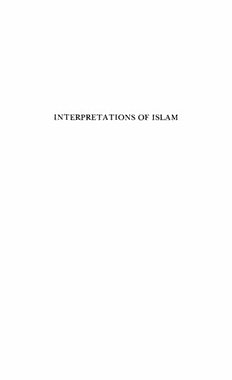
Interpretations of Islam: Past and Present PDF
Preview Interpretations of Islam: Past and Present
INTERPRETATIONS OF ISLAM INTERPRETATIONS o f ISLAM PAST AND PRESENT By Emmanuel Sivan The Darwin Press, Inc. Princeton, New Jersey Copyright© 1985 by the darwin press, inc., Princeton, nj 08540 usa All rights reserved. No part of this publication may be reproduced, stored in a retrieval system, or transmitted, in any form, by any means, electronic, me chanical, photocopying, recording, or otherwise, without the prior permission of the publisher, except in the case of brief quotations in critical articles or reviews. Library of Congress Cataloging in Publication Data Sivan, Emmanuel. Interpretations of Islam. Includes index. 1. Arab countries—Historiography—Addresses, essays, lectures. 2. French—Algeria—Addresses, essays, lectures. I. Title. DS37.S57 1985 909\097671’0072 84-70415 ISBN 0-87850-049-9 Printed in the United States of America CONTENTS Introduction ................................................................................. ix Part I: History Interpreted 1. Modern Arab Historiography of the Crusades .................... 3 2. Arab Revisionist Historians .................................................. 45 Part II: Impact of the Past upon the Present 3. The Sanctity of Jerusalem in Islam ...................................... 75 4. ‘Ulama and Power ................................................................. 107 5. Edward Said and His Arab Reviewers.................................. 133 Part III: Colonial Representations of Islam 6. Colonialism and Popular Culture......................................... 157 7. Hating the Jew as an Arab.................................................... 189 8. Slave Dealer Mentality and Communism............................. 207 Index .......................................................................................... 249 To My Mother INTRODUCTION THERE ARE, it has been said, two types of scholars: the divers who plunge deeper and deeper into the water, turning around the one object they covet, and the explorers who like to furrow the sea, in quest of boundless horizons, describing the various worlds they en counter along the way. It seems that I belong to the second category, hopping back and forth between medieval and contemporary Islamic history, between Mashriq and Maghrib, between the viewpoint of the Muslim native and that of the European colonizer. Yet, if there is a raison d’être to this activity, other than the sheer fun of exploration, it resides in the one recurring theme of my schol arly concerns—the relationship between the Islamic past and present. This collection of essays intends to illustrate the diverse aspects of this theme, perhaps in a better focused manner than I could do in my books. I begin by discussing the deep interest of modern Mus lims in their past, especially the Middle Ages, which attract them more than Westerners are attracted to their own (Western) Middle Ages. (Half of the Ph.D. dissertations in Egyptian universities, for instance, are devoted to medieval history.)* Two facets of this inter est—which one may call “history as a witness for the defense” and “history as a witness for the prosecution”—are discussed in Chapters 1 and 2 respectively. These interpretations illustrate the subjective presence of the past in the minds of contemporary Muslims, the past as represented by the modern observer. But the past has a more “objective” presence in modern realities through the legacies it left and which survive (in various and ever-changing forms), regard less of whether the contemporaries are conscious of it or not. Two such legacies are probed in Chapters 3 and 4. Chapter 5 attempts to place the same leitmotif in a broader scope—that of the debate on Orientalism launched by the book bearing this title by Edward Said. The one great merit of Said’s book is, undoubtedly, in stressing the “cultural archives” brought by scholars and observers to the study of Islam. Awareness of this fact, i.e., attention to one’s own prejudices and predilections, is the best guarantee against falling * See my “Egyptian Historiography: Quantitative Indicators,” Hamizrah Hehadash XXIII (Hebrew), 1973. IX x Interpretations of Islam into the pitfalls of extreme subjectivism, though objectivity will re main, at best, elusive. This is particularly true of the outside observ er, and even more so of the Western one whose civilization has long dominated (and in some ways still does) that of Islam. Studying the various representations of Islam by Westerners is one way to enhance such self-awareness. I have chosen to do so not at the level of high culture (discussed by Said and his reviewers, see Chapter 5), but by focusing on Western popular culture in one of the most intensive (and tragic) colonial situations, namely, French Algeria (see Chapters 6, 7, and 8). The lessons to be learned therefrom are all the more poignant, since the Pied Noirs were both a dominant class (in the colonial context) and a subordinate class (in the French context), both “Mediterranean” and “European.” Chapters 1, 2, 6, and 8 are reprinted here, more or less, as they originally appeared in English. Chapter 5 is a greatly expanded version of a 1977 article. Chapters 3, 4, and 7 appear here in English for the first time and were also revised or expanded. These essays were prepared for publication at the suggestion of my friend and mentor, Charles Issawi, during a year spent at the Institute for Advanced Study, Princeton. My thanks to the Institute and to its staff.
